Become a Member!
Support the Museum by becoming a member today!


| The Confederate States of America adopted three different national flag patterns between 1861 and 1865. The Provisional Confederate Congress adopted the First National pattern, also referred to as the “Stars and Bars,” on March 4, 1861. This pattern flag flew over the Capitol at Montgomery, Alabama, where the Provisional Congress met prior to the bombardment of Fort Sumter in April 1861. | 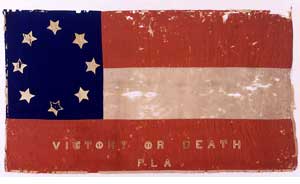 |
| The Second National pattern, also referred to as the “Stainless Banner,” was adopted May 1, 1863 and incorporated the Army of Northern Virginia’s battle flag design in the canton on a white field. The first official use of the Second National pattern flag was on Stonewall Jackson's casket when his body lay in state in Richmond, May 10, 1863. | 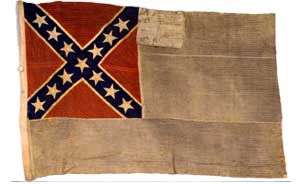 |
| The Third National pattern, adopted March 4, 1865, shortened the white field and added a vertical red bar to the end of the Second National pattern flag. Very few, if any, of the Third National pattern flags saw service during the war, since General Lee's Army of Northern Virginia surrendered just a few weeks later at Appomattox. | 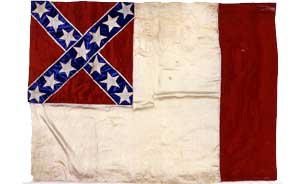 |
| In addition to the national flags of the Confederacy, there were many battle flag patterns used by the Confederate armies. The following are among the battle flag patterns represented in the Museum’s collection: | |
| The Army of Northern Virginia pattern battle flag, first issued to units beginning in November 1861, was designed to be a distinctive flag for use on the battlefield. It underwent numerous revisions in design and materials throughout the war. Although this particular flag is the most common flag pattern associated with the Confederate States of America, the Confederate Congress never officially adopted this flag, except as the canton of the Second and Third National patterns. | 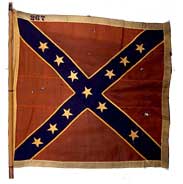 |
| The Hardee pattern battle flag was designed by Gen. Simon Buckner who led a division under Gen. William Hardee. According to an anonymous soldier under Buckner’s command, Buckner’s wife made flags that had "no artistic taste about it, but which could not be mistaken." The Hardee pattern battle flag was issued to units beginning in November 1861. It featured a blue field with a white border enclosing a full moon. | 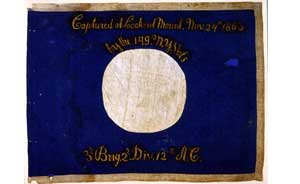 |
| The Polk pattern battle flag, which incorporated a St. George’s cross, was designed by Gen. Leonidas Polk, an Episcopal bishop before the war. It was issued to units beginning in January 1862. It incorporated eleven white stars on a red St. George's cross on a blue field. | 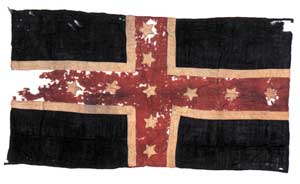 |
| The Van Dorn pattern battle flag was carried by The Army of the West under the command of Gen. Earl Van Dorn and was issued to units in 1862; June through September 1862 are the generally accepted issue dates, but the flag may have been used as early as March 1862. It featured thirteen white stars and a crescent moon on a red field. | 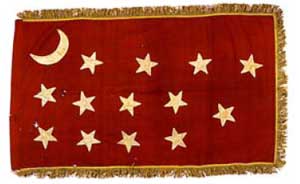 |
| The Army of Tennessee pattern battle flag was ordered by Gen. Joseph Johnston in an attempt to standardize the flags carried by the Western Army. This rectangular design with no borders was based on the Army of Northern Virginia battle flag. The Army of Tennessee pattern battle flag was issued to units beginning in January 1864. It incorporated twelve to thirteen white stars on a blue St. Andrew's cross on a red field. | 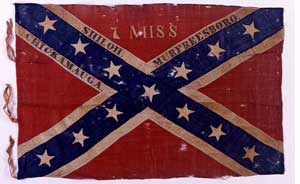 |
After the Civil War, 545 captured Confederate flags were held by the U.S. War Department in Washington, D.C. These flags were stenciled with a number in black ink and, in some cases, capture histories were handwritten on linen tags sewn onto the flag. Detailed records were kept so that the government could award the Congressional Medal of Honor for capturing an enemy flag. Today, these records, detailed in the National Archives’ Register of Captured Flags, are valuable tools for historians.
In 1905, Congress passed legislation returning the captured flags to the Southern States. The Museum of the Confederacy was the recipient of the Commonwealth of Virginia’s 75 repatriated flags. In 1906, another 252 flags from unidentified Confederate units were also entrusted to the Museum, creating the world’s largest collection of Wartime flags.

Contact us | Feedback
| Site Map
The Museum
of the Confederacy Headquarters,
1201 E. Clay Street, Richmond, VA
23219
Toll-free 855.649.1861
Outside of the US
1.804.649.1861
Museum of the Confederacy and nearby Richmond hotels
